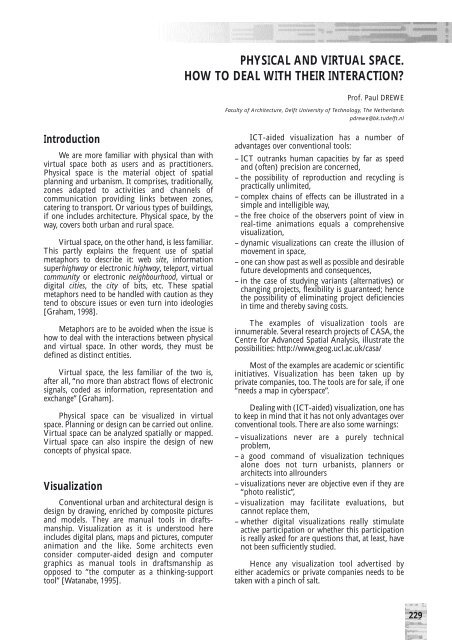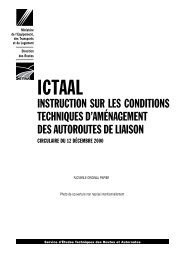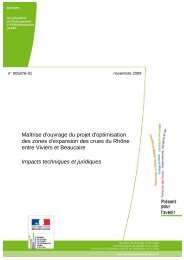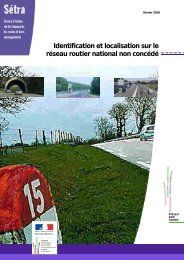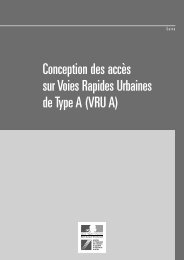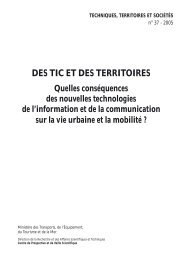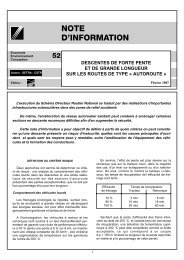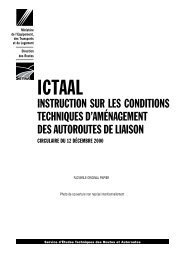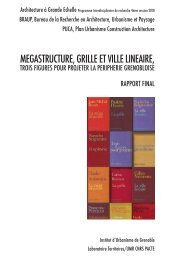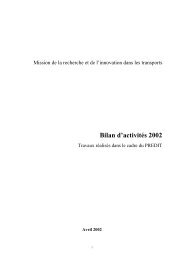Daniel Kaplan - Portail documentaire du Ministère de l'Ecologie
Daniel Kaplan - Portail documentaire du Ministère de l'Ecologie
Daniel Kaplan - Portail documentaire du Ministère de l'Ecologie
You also want an ePaper? Increase the reach of your titles
YUMPU automatically turns print PDFs into web optimized ePapers that Google loves.
Intro<strong>du</strong>ction<br />
We are more familiar with physical than with<br />
virtual space both as users and as practitioners.<br />
Physical space is the material object of spatial<br />
planning and urbanism. It comprises, traditionally,<br />
zones adapted to activities and channels of<br />
communication providing links between zones,<br />
catering to transport. Or various types of buildings,<br />
if one inclu<strong>de</strong>s architecture. Physical space, by the<br />
way, covers both urban and rural space.<br />
Virtual space, on the other hand, is less familiar.<br />
This partly explains the frequent use of spatial<br />
metaphors to <strong>de</strong>scribe it: web site, information<br />
superhighway or electronic highway,teleport, virtual<br />
community or electronic neighbourhood, virtual or<br />
digital cities, the city of bits, etc. These spatial<br />
metaphors need to be handled with caution as they<br />
tend to obscure issues or even turn into i<strong>de</strong>ologies<br />
[Graham, 1998].<br />
Metaphors are to be avoi<strong>de</strong>d when the issue is<br />
how to <strong>de</strong>al with the interactions between physical<br />
and virtual space. In other words, they must be<br />
<strong>de</strong>fined as distinct entities.<br />
Virtual space, the less familiar of the two is,<br />
after all, “no more than abstract flows of electronic<br />
signals, co<strong>de</strong>d as information, representation and<br />
exchange” [Graham].<br />
Physical space can be visualized in virtual<br />
space. Planning or <strong>de</strong>sign can be carried out online.<br />
Virtual space can be analyzed spatially or mapped.<br />
Virtual space can also inspire the <strong>de</strong>sign of new<br />
concepts of physical space.<br />
Visualization<br />
Conventional urban and architectural <strong>de</strong>sign is<br />
<strong>de</strong>sign by drawing, enriched by composite pictures<br />
and mo<strong>de</strong>ls. They are manual tools in draftsmanship.<br />
Visualization as it is un<strong>de</strong>rstood here<br />
inclu<strong>de</strong>s digital plans, maps and pictures, computer<br />
animation and the like. Some architects even<br />
consi<strong>de</strong>r computer-ai<strong>de</strong>d <strong>de</strong>sign and computer<br />
graphics as manual tools in draftsmanship as<br />
opposed to “the computer as a thinking-support<br />
tool” [Watanabe, 1995].<br />
PHYSICAL AND VIRTUAL SPACE.<br />
HOW TO DEAL WITH THEIR INTERACTION?<br />
Prof. Paul DREWE<br />
Faculty of Architecture, Delft University of Technology, The Netherlands<br />
pdrewe@bk.tu<strong>de</strong>lft.nl<br />
ICT-ai<strong>de</strong>d visualization has a number of<br />
advantages over conventional tools:<br />
– ICT outranks human capacities by far as speed<br />
and (often) precision are concerned,<br />
– the possibility of repro<strong>du</strong>ction and recycling is<br />
practically unlimited,<br />
– complex chains of effects can be illustrated in a<br />
simple and intelligible way,<br />
– the free choice of the observers point of view in<br />
real-time animations equals a comprehensive<br />
visualization,<br />
– dynamic visualizations can create the illusion of<br />
movement in space,<br />
– one can show past as well as possible and <strong>de</strong>sirable<br />
future <strong>de</strong>velopments and consequences,<br />
– in the case of studying variants (alternatives) or<br />
changing projects, flexibility is guaranteed; hence<br />
the possibility of eliminating project <strong>de</strong>ficiencies<br />
in time and thereby saving costs.<br />
The examples of visualization tools are<br />
innumerable. Several research projects of CASA, the<br />
Centre for Advanced Spatial Analysis, illustrate the<br />
possibilities: http://www.geog.ucl.ac.uk/casa/<br />
Most of the examples are aca<strong>de</strong>mic or scientific<br />
initiatives. Visualization has been taken up by<br />
private companies, too. The tools are for sale, if one<br />
“needs a map in cyberspace”.<br />
Dealing with (ICT-ai<strong>de</strong>d) visualization, one has<br />
to keep in mind that it has not only advantages over<br />
conventional tools. There are also some warnings:<br />
– visualizations never are a purely technical<br />
problem,<br />
– a good command of visualization techniques<br />
alone does not turn urbanists, planners or<br />
architects into allroun<strong>de</strong>rs<br />
– visualizations never are objective even if they are<br />
“photo realistic”,<br />
– visualization may facilitate evaluations, but<br />
cannot replace them,<br />
– whether digital visualizations really stimulate<br />
active participation or whether this participation<br />
is really asked for are questions that, at least, have<br />
not been sufficiently studied.<br />
Hence any visualization tool advertised by<br />
either aca<strong>de</strong>mics or private companies needs to be<br />
taken with a pinch of salt.<br />
229


